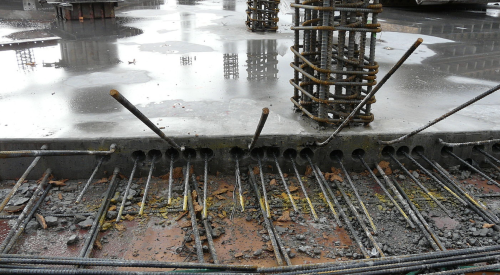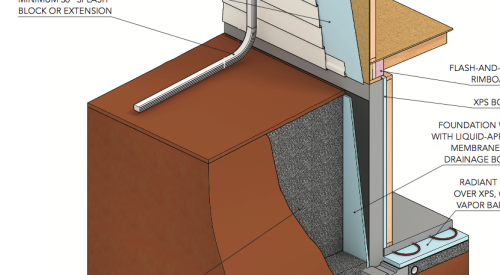The typical chemical application for termites in new construction is about 282 gallons of termiticide for a 1,500-square-foot house. That's a lot of chemicals in the ground. And one dose lasts roughly 5 years, so it must be repeatedly reapplied.
Many experts feel that, left undisturbed, today's termiticides pose no threat to humans or the environment. But for some clients, no pesticide is safe enough, and for those with chemical sensitivities or children who love to dig in the yard, termiticides may be intolerable. Sites with wells or high water tables also don't lend themselves to regular pesticide use, and some soils and foundations are particularly difficult to treat.
These concerns have lead to the development of physical barrier alternatives, which are permanently installed during construction. Physical barriers can isolate vulnerable elements of the house or protect the foundation perimeter. They won't kill termites, but they will force them to tube in places that are visible.
If you opt for barriers in lieu of chemicals, the Partnership for Advancing Technology in Housing (PATH) recommends reducing termite infestation with the following:
Termite ShieldsThe easiest and cheapest option is termite flashings, or shields, which provide a physical barrier between the foundation and wood structural elements. Regular flashing materials also work as termite shields. The Southface Energy Institute advises that shields be installed continuously under the sill plate of the building and extend beyond other building materials. This forces termites into the open for easy detection.
In high-termite areas, you may need a more aggressive method of control. The main entry points for termites are pipe penetrations, construction joints and biggest of all, bath traps. Flashing may not fit snugly enough around pipe penetrations to ward off determined populations.
According to Bill Koehler, professor of entomology of the University of Florida, common pipe wraps provide termites access into the house and protect them from soil termiticides as they enter through slab penetrations. Pipe wraps are required for copper but optional for CPVC pipe. If the building code allows it, Koehler recommends omitting pipe wraps around CPVC pipes. However, the use of a physical barrier around pipes, Koelher notes, solves the problem completely.
Your choices are aggregates and stainless steel mesh.
Aggregates and MeshAggregates contain rock, sand or another large medium that is too large for termites to chew but too small to pass through. Distribution in the U.S. is limited, so stainless steel mesh is the only practical barrier alternative for U.S. builders.
Stainless steel mesh is a finely woven, marine-grade screen that is used to create a continuous physical barrier between new construction and ground contact. The edges of the mesh form to the concrete, and hole openings are protected.
Ray Tonjes, owner of Ray Tonjes Builder in Austin, Texas, and chair of NAHB's Green Subcommittee, recommends the mesh system.
Tonjes has experimented with various physical barriers, particularly a coarse sand barrier, but found it difficult to adapt. Metal flashing, he says, doesn't really work around plumbing penetrations. In 2000, he tried stainless steel mesh and found it works around plumbing penetrations and cold joints, and it can be installed around the perimeter. He claims a success rate of 100 percent but notes tricky parts: you have to educate other trades on its use and application so they don't alter the installation before pouring the foundation.
As with all methods of termite protection, homes with mesh should be inspected regularly — perhaps as often as twice a year in states with heavy infestation. This also means it's important to keep the slab viewable from the outside. Leave at least 6 to 8 inches of slab visible for inspections, and discourage homeowners from planting near the foundation.
According to Termimesh, cost depends on building design. The number of penetrations influences price. To keep costs down and also to reduce the number of termite entry points, the manufacturer recommends running water lines and electrical conduits overhead and limiting joints in slabs.
| Author Information |
| Susan Conbere writes about better building practices on behalf of the Partnership for Advancing Technology in Housing (PATH). Learn more at www.pathnet.org. |
|











